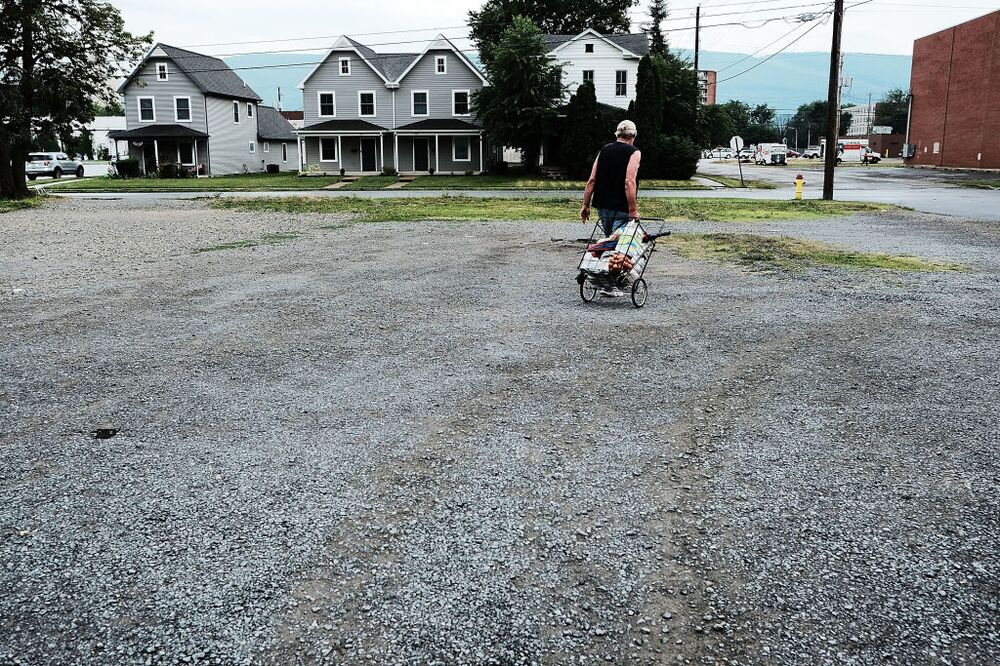Statistics don’t quite capture the extent of U.S. poverty. A new measure could change that.
Politics & Policy
America Is Poorer Than It Thinks
https://www.bloomberg.com/opinion/articles/2018-11-26/poverty-in-america-greater-than-statistics-indicate?utm_content=business&utm_source=facebook&cmpid=so
Statistics don’t quite capture the extent of U.S. poverty. A new measure could change that.By
Noah Smith2018年11月26日 下午9:00 [GMT+8]

Anxiety about hunger is debilitating, too. Photographer: Spencer Platt/Getty Images North America
Noah Smith is a Bloomberg Opinion columnist. He was an assistant professor of finance at Stony Brook University, and he blogs at Noahpinion.
Read more opinionFollow @Noahpinion on TwitterCOMMENTS
What does it mean to be poor? Currently there are two basic ways to define poverty. To get a better measure of who needs help — and a better sense of how to provide it — society needs a third definition.
The first definition is absolute poverty — essentially, material destitution. Human beings need food, water and shelter, and if we can’t afford these things, life is pretty miserable. In the U.S., the federal government has
poverty guidelines that are based on food consumption: If you make less than about three times the minimum amount people need to spend on food each year, you’re poor.
By this measure, a single adult living on $12,140 or less is considered poor as of 2018. For a family of four, the figure is $25,100. There is also a
Supplemental Poverty Measure that includes not just food but clothing, shelter and utilities. Thanks in part to increased government assistance, U.S. poverty according to this measure
has fallen, especially
for children.
Critics of the federal poverty guidelines argue that these numbers are too low, thanks to growing inequality — in the 1960s, the federal poverty level was about half of the median income, but is now well below that. Moreover, as a country grows richer, hunger becomes less common, so using it as measure of poverty becomes less useful. When the middle class is defined by having “a chicken in every pot and a car in every backyard” (a
campaign slogan from 1928), then simply having a chicken would seem to indicate that you’re not poor. But when your middle-class neighbors have several
cars, several
televisions and spacious
homes, you might feel poor.
This is where the second measure — relative poverty — comes in. The Organization for Economic Cooperation and Development defines poverty this way: If you earn less than half of the median income, you’re poor. By this measure, the U.S. is doing a bit worse than other rich countries:
Poverty Is Relative
By one measure, the poverty level in the U.S. is higher than in many other wealthy nations
Source: Statista.com
Data from 2015.
But this, too, feels unsatisfying. Imagine a future U.S. in which the median American is fabulously wealthy — with flying cars, robot servants, and multiple overseas vacations every year. Should someone with half as many flying cars, robot servants and overseas vacations be considered poor? That seems like a stretch.
Intuitively, then, it seems that a third definition of poverty is necessary — one that measures more than just material well-being but also takes into account economic growth.
Luckily, there is just such a concept: It’s called material security. Psychologist Abraham Maslow
believed that safety ranked second only to food and shelter as a basic human need. Someone who has food and a roof over their head today, but doesn’t know whether they will tomorrow, should be considered poor.
Imagine a 55-year-old single woman with diabetes working a part-time job making close to minimum wage. Thanks to government assistance, her total income is $15,000 a year. But if she loses her job or has a medical emergency — both of which, as Matthew Desmond’s book “
Evicted: Poverty and Profit in the American City” illustrates, are sadly common — she will probably become homeless. That in turn will make it very hard to get a new job, or to pay for her future health-care needs. In short, her situation is very precarious.
As Maslow would predict, this kind of insecurity causes extreme stress. And this precariousness exists along several dimensions — housing, health care, income, the risk of violence — which makes it hard to capture in a single measure. Still, there are some existing measures that could be used to help create a composite picture of security-based poverty.
For example, the U.S. Department of Agriculture tracks
food insecurity, a survey-based measure of how worried people are that their food will run out. Economists track
income volatility, which measures swings in earnings from year to year. This kind of risk has been on the rise in the U.S.:
A World of Uncertainty
Index of two-year income variance by age group
Source: Robert Moffitt and Sis Zhang, "Income Volatility and the PSID: Past Research and New Results," Johns Hopkins University; author's calculations
The risk of eviction, meanwhile, can be roughly measured by the percentage of people’s incomes that they spend on shelter each month. As of 2015, 17 percent of Americans spent half or more of their incomes on rent.
A reasonable, common-sense definition of poverty should include not just an absolute measure of material deprivation and a relative gauge of a person’s situation compared to the rest of society. It should also strive to measure how secure people feel — in their homes, their health, and their jobs.
This new measure might well show that poverty in the U.S. is worse than the current statistics say. But an accurate view of a problem is the first step toward addressing it. And eliminating poverty should be a priority of any wealthy society.

 Anxiety about hunger is debilitating, too. Photographer: Spencer Platt/Getty Images North America
Anxiety about hunger is debilitating, too. Photographer: Spencer Platt/Getty Images North America Kilogram No. 20, in the U.S., is one of several “working standards.” Credit: Science Source
Kilogram No. 20, in the U.S., is one of several “working standards.” Credit: Science Source